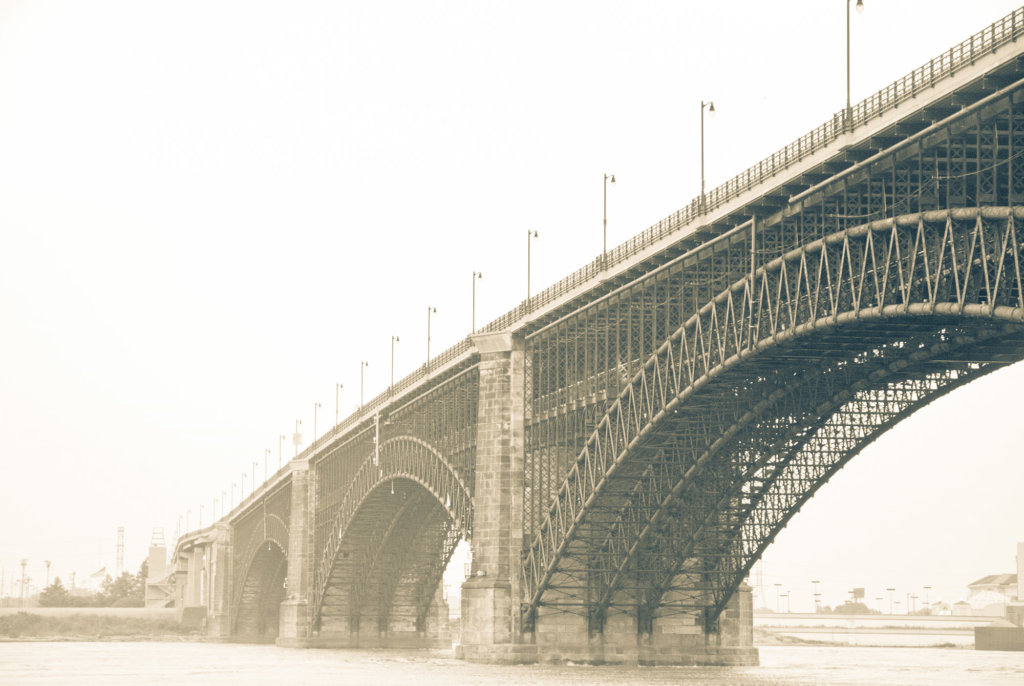

Eads Bridge, by Kenton Smith
In the mid-1800s, steamboats owned the river. Anything and anyone coming or going from St. Louis crossed the river by steamboat. Rail cargo was offloaded, ferried across the river, and reloaded onto another train. The wide and swift Mississippi River posed unprecedented challenges to any would-be bridge builders, and that’s if they could overcome the political and economic opposition from the steamboat business. But James Buchanan Eads had a learned distrust of riverboats and deep determination—a necessary combination to construct the unbuildable bridge.
The Eads Bridge is a three-arch, steel truss bridge. Completed in 1874, it was the largest bridge of its time, the first of its kind, and the only place a train could cross the Mississippi River.
James B. Eads was a born frontiersman. On the way to St. Louis with his mother and sisters, their steamboat caught fire near the wharf. The family escaped with their lives, but the boat sank with their livelihoods. To help his family rebuild, he joined the crew of the steamboat Knickerbocker.
A riverboat traveling as far north as Wisconsin and back will teach its crew many things about the river. Eads’ time working on a cargo boat revealed the behavior of the river’s opaque surface. He saw dozens of boats sink from boiler explosions and hidden underwater snags. Some of these sunken boats carried very valuable cargo, leading to his next business venture: underwater salvage.
Eads’ pioneering design of a diving bell made from a wooden barrel had him walking on the bottom of the river recovering sunken treasures for well-paying contractors. The 22-year-old engineer (given the honorary title of Captain) experienced firsthand the behavior of the riverbed: the ground constantly changing as both silt and sand flow like water. James Eads’ understanding of the Mississippi, from its surface to its depths, was profound. Although he had never built a bridge, his thorough knowledge of the river endowed him with great trust, and he won the bid to build the first bridge connecting Illinois and Missouri where they meet in St. Louis.
The center arch of the bridge spans over five hundred feet to keep from inhibiting freight traffic, and the whole bridge clears a mile in length. This incredible distance meant that a suspension bridge was off the table, and the piers (vertical support beams) would stand in the river itself. Eads’ familiarity with the riverbed informed him of the fact that just setting the piers in the silt would not hold. They would have to dig down through 80 feet of sand and mud under 20 feet of water.
The Eads Bridge was a first in its use of pneumatic caissons to excavate and construct bedrock supports. A caisson functions similarly to a diving bell: when a large metal container with an open bottom is pushed straight down into the water, an air pocket forms. Imagine forcing a cup, open end down, into a bathtub or swimming pool. As the caisson descends, pressure from the weight of the water grows around it. If the surrounding water pressure exceeds the inside air pressure, the water will force the air out of the caisson. The solution is to continually pump air into the caisson, increasing air pressure as it dives, maintaining a balance. The building of the Eads Bridge required one of the largest caissons in history.
The bridge opened on July 4th, 1874. The city of St. Louis crossed the Mississippi River, and the Eads Bridge connected the city to the eastern half of the nation. Rail and road traffic had direct access to St. Louis.
In the riverside humidity and July heat, 300,000 people turned out for the Independence Day Parade where the bridge was dedicated. As proof of its stability, the parade followed an elephant across the bridge. Elephants have a sixth sense and won’t cross an unstable bridge, so goes the legend. And the science holds up: elephants have extremely acute senses. On questionable ground, an elephant will pound the surface with its trunk to test its sturdiness, placing each foot only in tested spots, and stepping in its own footprints as it moves forward. Such surface testing was not necessary on the incontrovertibly strong Eads Bridge.
Nearly a century later in 1964, the National Park Service bestowed the Eads Bridge its highest designation, a National Historic Landmark. In 1971 it was designated a City Landmark and a National Historic Engineering Landmark. On June 25th, 1989, James B. Eads was inducted into the St. Louis Walk of Fame. You can find his star at 6635 Delmar Blvd.
Eads stated that his bridge would remain in use as long as people saw a use for it. For a time, it was abandoned. Freight trains outgrew the bridge in 1974, and in 1991, road traffic stopped too. The bridge found new purpose with passenger trains when the St. Louis Metrolink put the railway to use in 1994. Road traffic resumed in 2003 when a brand new four-lane highway opened across the Eads Bridge. “Drive on,” Eads would say, “Fortune favors the brave.”